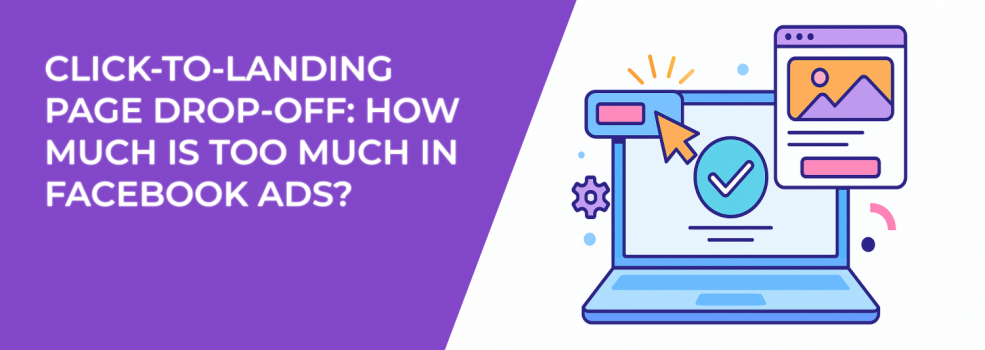Getting clicks on your Facebook ads feels like progress. But here’s the catch: clicks don’t guarantee that people actually reach your landing page. Many users drop off in the seconds after clicking, and you may never even notice it unless you’re looking closely.
That gap between clicks and actual visits is called click-to-landing page drop-off. And it can quietly drain your budget.
What Is Click-to-Landing Page Drop-Off?
Put simply, this metric shows how many people click your Facebook ad but never arrive on your landing page.
Think of it as a bridge. People step onto it when they click your ad, but some never make it across to the other side. The reasons vary — technical glitches, impatience, or even curiosity clicks that were never intentional.
The number matters because every drop-off is wasted money. If a large share of your audience disappears before your landing page loads, you’re paying for traffic that doesn’t even get the chance to convert.
If you’ve ever struggled with Facebook ads not converting, understanding this metric might reveal one of the hidden reasons behind your results.
How Much Drop-Off Is Normal?
No campaign has a perfect 0% drop-off. There will always be small losses. Maybe someone loses their internet connection, maybe they get distracted and close the tab, or maybe analytics tools miss a session here and there.
So what’s acceptable? Industry benchmarks suggest:
-
5–15% drop-off → normal and nothing to stress over.
-
15–20% drop-off → signals room for improvement.
-
Over 20% → urgent issue that’s costing you real money.
Think about the math. If you’re paying $2 per click and 25% of users never see your page, that’s $500 lost out of every $2,000 you spend. That kind of waste adds up quickly, and fixing it is often easier than you think.
For context, advertisers often focus on CTR and CPC benchmarks. But measuring beyond those, as shown in how to analyze Facebook ad performance beyond CTR and CPC, gives you a much clearer picture of what’s actually happening.
Why Do People Drop Off?
Drop-off doesn’t happen for one single reason. It usually comes from a combination of technical barriers and user behavior. Knowing the most common causes helps you spot problems faster.
For example, one of the biggest culprits is slow page speed. People are impatient, and in a mobile-first world, even a delay of three or four seconds is enough to make them leave.
Another common issue is design. If your landing page isn’t optimized for mobile — which is where most Facebook traffic comes from — visitors will have trouble navigating or interacting.
Other common reasons include:
-
Ad-to-page mismatch – If the ad promises one thing but the landing page delivers something different, trust is lost instantly.
-
Tracking errors – Sometimes the drop-off isn’t real but comes from broken or double-counted pixels.
-
Accidental clicks – Certain placements attract clicks from users who never meant to engage in the first place.
If this sounds familiar, you’re not alone. Many marketers underestimate the role of relevance. As explored in why Facebook ads fail: 7 targeting issues you didn’t know about, poor audience alignment often makes drop-off worse.
How to Measure Drop-Off
You can’t fix what you can’t measure. Luckily, tracking drop-off is simple once you know what to compare.
The basic formula is this:
-
Look at clicks in Facebook Ads Manager.
-
Look at sessions in Google Analytics (or a similar tool).
-
Subtract sessions from clicks to find your drop-off rate.
For example, 1,000 clicks and 850 sessions means a 15% drop-off. That’s within the normal range.
But don’t stop at the overall number. Dig deeper. Break down drop-off by:
-
Device type – Are mobile users bouncing more than desktop?
-
Browser – Do Safari users have a higher drop-off than Chrome?
-
Campaign – Is one ad creative driving more irrelevant clicks?
This extra layer of analysis often reveals where the real problem is hiding.
How to Reduce Drop-Off
The good news? A high drop-off rate is usually fixable. Many advertisers overlook it, but with a few adjustments, you can keep more people on the page and stretch your budget further.
The first step is page speed. Test your landing page with tools like Google PageSpeed Insights. If it loads in more than three seconds, you’re losing visitors. Compress images, cut unnecessary scripts, and consider upgrading your hosting.
Next, think about how your page looks on mobile. Most users will be visiting from their phones, so the page needs to be clean, easy to navigate, and fast to scroll through.
Here are some practical tactics to try:
-
Speed improvements – Use lightweight images, limit auto-play videos, and install caching.
-
Mobile checks – Test forms with your thumb, not just a mouse. Make sure text and buttons resize properly.
-
Message alignment – If your ad promotes a discount or free trial, that exact offer should be front and center on the landing page.
-
Simple design – Too many pop-ups, widgets, or sidebars distract users and push them to exit.
-
Tracking audits – Check that your Facebook Pixel and Google Tag Manager scripts are firing correctly.
Even small adjustments can make a noticeable difference. Cutting drop-off from 25% to 15% may not sound dramatic, but it means more people actually reach your page — without increasing your ad spend.
When to Take Action
The question isn’t whether you’ll have drop-off. The question is how much is too much.
If your campaigns consistently show over 20% drop-off, it’s time to treat it as a priority. Think of it this way: one out of every five people you paid for is disappearing before they even see your message.
Would you accept that kind of waste in a physical store? Imagine customers walking toward your entrance, but a fifth of them vanish before reaching the door. You’d fix the problem immediately. Online ads should be treated the same way.
Final Thoughts
Click-to-landing page drop-off doesn’t get as much attention as CTR or conversion rate, but it’s a critical piece of the funnel. Ignoring it means letting money slip through the cracks.
The best part? Fixing it is usually straightforward. A faster page, a mobile-friendly design, and consistent messaging can turn wasted clicks into engaged visitors.
If you start tracking this metric regularly, you’ll catch problems earlier and save a significant share of your ad budget. That’s money you can reinvest into scaling your campaigns — instead of losing it in the gap between click and page.

